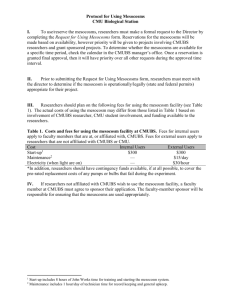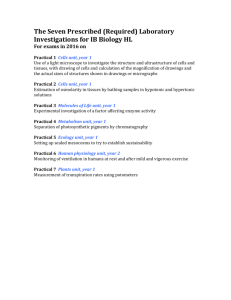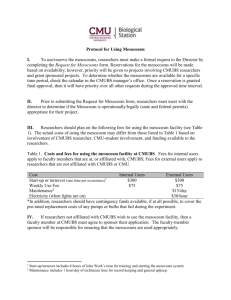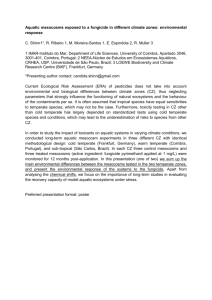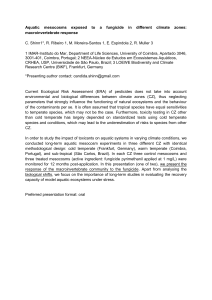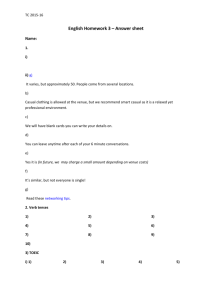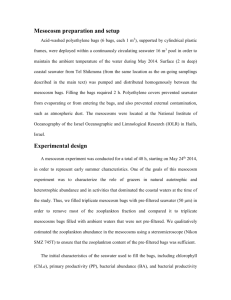Experimental Venue and Estimation of Interaction Strength Author(s): David K. Skelly Source:
advertisement
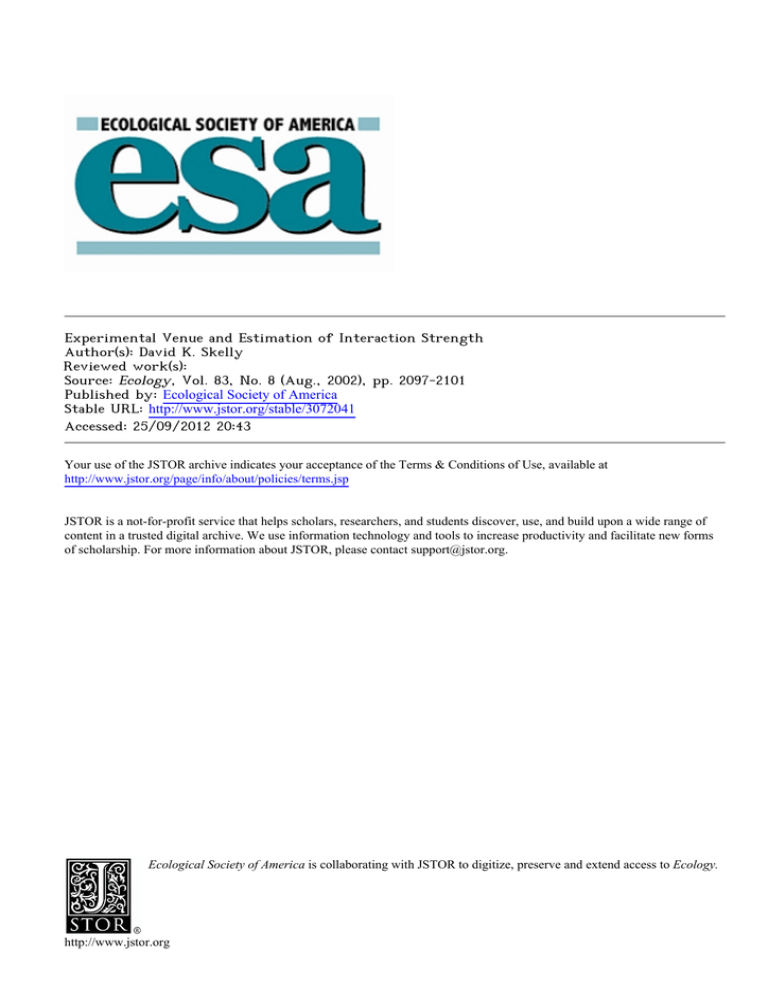
Experimental Venue and Estimation of Interaction Strength Author(s): David K. Skelly Reviewed work(s): Source: Ecology, Vol. 83, No. 8 (Aug., 2002), pp. 2097-2101 Published by: Ecological Society of America Stable URL: http://www.jstor.org/stable/3072041 . Accessed: 25/09/2012 20:43 Your use of the JSTOR archive indicates your acceptance of the Terms & Conditions of Use, available at . http://www.jstor.org/page/info/about/policies/terms.jsp . JSTOR is a not-for-profit service that helps scholars, researchers, and students discover, use, and build upon a wide range of content in a trusted digital archive. We use information technology and tools to increase productivity and facilitate new forms of scholarship. For more information about JSTOR, please contact support@jstor.org. . Ecological Society of America is collaborating with JSTOR to digitize, preserve and extend access to Ecology. http://www.jstor.org Ecology, 83(8), 2002, pp. 2097-2101 C 2002 by the Ecological Society of America EXPERIMENTAL VENUE AND ESTIMATION OF INTERACTION STRENGTH DAVID K. SKELLY' School of Forestry & Environmental Studies and Department of Ecology & Evolutionary Biology, Yale University, 370 Prospect Street, New Haven, Connecticut 06511 USA Ecologists utilize laboratories, mesocosms, and field environments as the Abstract. settings for their experiments. However, the ways in which these venues influence experimental outcomes remain poorly understood. I tested the effect of experimental venue by conducting parallel manipulations in mesocosms and in the field. A target-neighbor experiment estimating the impact of larval wood frog (Rana sylvatica) density on the performance of spring peeper (Pseudacris crucifer) larvae was carried out in a set of artificial pond mesocosms and within mesh enclosures placed in natural ponds. Larvae of P. crucifer suffered sharp reductions in growth and development in the presence of increasing R. sylvatica densities when reared in mesocosms, but showed no response in field enclosures. A comparative test suggested that mesocosms yielded relatively unrealistic responses. These findings demonstrate that, apart from other considerations such as spatial scale, experimental venue can alter conclusions regarding interactions between species. If venue dependence is widespread, ecologists will need to strategically assess the choice of venue when considering the goals of their experiments. Key words: amphibian; Anura; competition, effects on growth and development; experimental design trade-off; field experiments vs. mesocosm experiments; mesocosms; Pseudacris crucifer; Rana sylvatica; realism in experiments; trade-off. INTRODUCTION Over the last three decades, experimentation has become fundamental to ecology (Paine 1994). The many reasons to embrace an experimental approach are matched by a challenge to experiment effectively. This is because all experiments are contrivances; the aspects of experimentation that afford control, precision, and replication can simultaneously encourage outcomes that are artifacts rather than revelations about nature (Werner 1998). Of course, ecologists are well aware that experiments can mislead in this way (as evidenced by discussions of "cage effects"). But relatively rarely do we investigate the extent to which our results and conclusions depend on details of experimental protocol, and hence are vulnerable to misinterpretation. In this report I focus on the issue of experimental venue. One of the primary strategic decisions faced by an experimenter is the choice of setting. While commentators have suggested that tractability must be traded for realism when deciding to experiment within laboratories, in mesocosms, or in the field (Diamond 1986, Hairston 1989, Morin 1998), the effect of venue choice has not been experimentally estimated. Here, I present results from parallel manipulations conducted within comparably scaled mesocosms and mesh field enclosures. I used a target-neighbor design in which a constant density of spring peeper (Pseudacris crucifer) larvae was exposed to a range of larval wood frog (Rana sylvatica) densities in order to estimate the response of P. crucifer growth, development, and survival. The experiment began shortly after hatching and was concluded just before the most developmentally advanced larvae began reaching metamorphosis. This design allowed me to estimate interaction strength between species, and, additionally, to use responses from mesocosms and field enclosures to predict attributes of wild populations. Because I found that venue had strong effects on experimental outcome, I used comparative effectiveness of these predictions as a gauge of the relative realism of the venues. METHODS I used a target-neighbor experimental design in which Pseudacris crucifer were targets and Rana sylvatica were neighbors. In each experimental unit, a constant density (20 individuals) of P. crucifer was stocked in the presence of one of four densities of Rana sylvatica (0, 20, 80, or 320 individuals). The experiment was conducted in two venues: mesocosm and field. The definitions of mesocosm and field vary among systems and scientists. In conducting an experiment on larval amphibians, I used the conventions and typical methods developed to study the residents of small freshwater ponds using mesocosm and fieldbased approaches (e.g., Brockelman 1969, Wilbur 1972, 1987, Morin 1983). Mesocosms were constructed from plastic cattle-watering tanks (152-cm diameter) located at the 3500-ha Yale-Myers Forest in Eastford, Connecticut, USA. Field experimental units were-mesh constructed to have the same bottom surface received13 November2001; revised7 February enclosures Manuscript area as the cattle tanks (134 X 134 cm). These enclo2002; accepted14 February2002. sures were placed in four natural ponds at the Yale' E-mail:david.skelly@yale.edu 2097 U 2098 * S DAVID K. SKELLY Myers Forest. The 4 X 2 design was replicated four times for a total of 32 experimental units. Mesocosms were filled with well water on 1 and 2 April 2001. Upon filling, 50 g of Purina Rabbit Chow (Ralston Purina Company, Saint Louis, Missouri, USA) was placed in each tank. Six hundred grams of forest litter consisting primarily of Quercus, Betula, and Acer leaves, was added to each mesocosm on 6 April 2001. Each mesocosm was inoculated with phytoplankton and zooplankton on 14 April 2001. Zooplankton were collected in each of the four experiment ponds using a 15 cm diameter, 153-Vtmmesh tow net. In each pond, twelve 5 m long horizontal tows from just below the water surface were collected. Samples from each pond were then combined and diluted to a volume of 16 L. One liter of this mixed inoculum was added to each mesocosm. Phytoplankton were added by collecting 4 L of unfiltered water from the top 15 cm of the water column in each of the four experiment ponds. These samples were combined, thoroughly mixed, and dispensed in 1-L aliquots to each of the 16 mesocosms. Enclosures were constructed of wooden frames and covered with mosquito mesh (0.5-mm mesh) on their tops, sides, and bottoms. In addition, the bottom panel was reinforced with aluminum screening (1.0-mm mesh). Enclosures were placed in ponds on 29 April 2001 and immediately received an allocation of 30 L of benthic litter collected previously from the basin of that pond and allowed to dry for 48 h. Mesocosms were filled to an initial depth of 48 cm and enclosures were placed in a comparable depth of water in each of the ponds. Depth measurements on three dates during the experiment revealed that venues did not differ (mesocosms: 46.0 ? 0.7 cm (mean + 1 SE, n = 16 experimental units; field enclosures: 47.4 + 1.4 cm, n = 16 experimental t = 0.78, P = 0.39). units; t test, df = 22, Recently laid R. sylvatica eggs were collected between 10 and 14 April 2001 from the four ponds where the experiment was conducted. Four masses were collected from each pond and placed in 20-L containers under a 14:10 light: dark cycle in a building subject to ambient temperature fluctuations. On 29 April 2001, R. sylvatica larvae (mass 9.7 + 0.7 mg [mean + 1 SE], n = 10 experimental units) from these masses were stocked into mesocosms and field enclosures according to the density treatment (each experimental unit received equal numbers of larvae from each of the four source ponds). P. crucifer larvae (mass 10.3 + 1.6 mg, n = 10) were collected from two different ponds (P. crucifer were not naturally present in the experiment ponds) on 4 May 2001 and equally allocated into mesocosms and enclosures on the same day. Surviving larvae were collected from mesocosms and enclosures on 7 and 8 June 2001. The experiment was concluded just before the most developmentally advanced larvae began reaching metamorphosis (Gosner stage 42, Gosner 1960) and well before drying of Ecology, Vol. 83, No. 8 any of the four natural ponds included in the experiment. Upon retrieval, larvae were weighed to the nearest milligram and then preserved in a solution of 70% ethyl alcohol for later staging. Simultaneous with the takedown of the experiment, an additional 20 R. sylvatica larvae were collected from the wild population resident in each of the four experiment ponds. Wild tadpoles were collected by sweeping a dipnet in areas throughout the pond basin. These animals were similarly weighed and preserved for later staging. I used analysis of variance to evaluate the influence of venue and R. sylvatica density on the survival (arcsine-transformed proportion), growth (final mass, in milligrams), and development (final Gosner stage) of P. crucifer. Scheff6 tests were used to evaluate differences among the density treatments in each venue and were calculated in each case where a significant effect of R. sylvatica density was detected by ANOVA. Linear regression was used to estimate the relationship between log-transformed final mass and stocking density of R. sylvatica in both mesocosms and field enclosures. The average mass and density of wildcaught R. sylvatica was compared to 95% confidence intervals around these relationships. Density of wild R. sylvatica was estimated using pipe sampling (based on a total of 10 visits to four natural ponds). Pipe sampling (Skelly 1996) involves the use of a 30-cm-diameter pipe that is dropped through the water column of natural ponds and sealed against the benthic litter. The captured volume of water within the pipe is then cleared using a dipnet. The pipe sampler is used repeatedly within a pond (12-64 samples per pond) in order to generate an estimate of the number of larvae per square meter. RESULTS P. crucifer larvae grew from an initial mass of 10 mg to a final mass of 173 mg, on average. Final mass (Fig. la) was strongly influenced by venue (ANOVA: MS = 263 574, F124 = 159.3, P < 0.001). At the end of the experiment, Pseudacris crucifer were more than 3 times heavier in mesocosms. Density of Rana sylvatica had a strong effect on P. crucifer final mass (ANOVA: MS = 52667, F324 = 31.8, P < 0.001), but an interaction between venue and R. sylvatica density indicated that the effect of R. sylvatica density was stronger in mesocosms than in field enclosures (ANOVA: MS = 29112, F324 = 18.1, P < 0.001). ScheffM tests revealed that P. crucifer final mass differed among R. sylvatica densities in mesocosms (P < 0.003 in each case), but not in field enclosures (all comparisons, P > 0.5). Within mesocosms, P. crucifer larvae from the highest density treatment reached just 20% of the mass achieved by conspecifics raised in the absence of R. sylvatica. Final Gosner developmental stage (Gosner 1960) of P. crucifer (Fig. Ib) was influenced by both venue (ANOVA: MS = 202.6, F1,24= 78.8, P < 0.001) and R. a) Final Mass A, 400.E 300300 oMesocosm II ;Field - cz200 C -~100 - 0 20 80 320 O 42 -I- 38 3 341 - 30 - o 26'F C U~22 Is 0 c) _- > 20 80 320 Survival 100 80-T un 60 ~40C 20 C,) 0 placed in mesocosms with the highest density of R. sylvatica larvae. Sixty-nine percent of all P. crucifer survived to the conclusion of the experiment (Fig. Ic). P. crucifer survived better in mesocosms (83%) than in field enclosures (55%; ANOVA: MS = 0.952, F124 = 12.2, P = 0.002) but survival did not differ among R. sylvatica density treatments (ANOVA: MS = 0.086, F3,24 = 1 -1, P = 0.368), nor was there an interaction between venue and R. sylvatica density (ANOVA: MS = 0.078, F324 = b) Final Development Stage C 20 80 Wood FrogDensity 320 FIG. 1. Attributesof Pseudacriscruciferlarvae collected from mesocosms andfield enclosures.TwentyP. cruciferlarvae were stocked into each mesocosm or enclosure; Rana sylvaticawere stockedat ratesof 0, 20, 80, or 320 individuals per experimentalunit. All larvae were at GosnerStage 22 or higherwhen they were stockedinto the experimentandwere at less thanGosnerStage 42 (metamorphiconset) at the conclusion of the experiment.Data are means and 1 SE. 1.0, P = 0.408). As an assay of the relative realism of the venues, I used information from the experiment to predict attributes of wild anurans in natural ponds. Each of the experiment ponds contained naturally present populations of R. sylvatica. Samples of these larvae were captured from each pond at the time the experiment was concluded. Responses from experimental units were used to predict body mass of these samples; R. sylvatica survived well in mesocosms and field enclosures (overall average survivorship: 8 1%). Fig. 2 shows the predicted relationships (and confidence intervals) between R. sylvatica larval density and body mass based on responses from mesocosms and from mesh field enclosures. The additional point plotted in Fig. 2 is the average mass of wild larvae collected at the termination of the experiment plotted against the average density of wild larvae. Estimates of mass and density of wild R. sylvatica larvae put them well outside the 95% confidence intervals generated from mesocosms, and well within confidence intervals around the relationship based on field enclosures. Thus, responses from mesocosms provided a poor basis for prediction, while responses from mesh field enclosures were excellent predictors of responses by wild populations. 8.0 density (ANOVA: MS = 27.2, F3,24 = 10.6, P < 0.001). An interaction (ANOVA, Venue X R. sylvatica density: MS = 16.2, F324 = 6.3, P = 0.003) suggested that the effect of R. sylvatica density was stronger in mesocosms than in field enclosures. P. crucifer final developmental stage differed among some R. sylvatica densities in mesocosms (ScheffM tests: 0 vs. 320, P < 0.001; 20 vs. 320, P < 0.001; 80 vs. 320, P < 0.001; other comparisons, P > 0.2), but not in field enclosures (Scheff6 tests: P > 0.5 in each case). Compared with their performance when alone, P. crucifer larvae developed less than half as rapidly when Mesocosms 7.5 co Wild . 77.0 6.5 sylvatica 2099 EXPERIMENTAL VENUE August 2002 -..* 6.0 - FieldEnclosures 5.5 0 ,I 50 I I 100 I I 150 I 200 No. Wood Frogs/M2 FIG.2. Relationshipbetween the naturallogarithmof final Rana sylvatica mass (originallymeasuredin milligrams) andR. sylvaticadensity.For mesocosmsandfield enclosures, density is the initial stockingdensity.Lines representbest fit and 95% confidenceintervals from least-squaresregression. A single point (cross) representsthe averagemass (errorbars indicate ? 1 SE) of wild-caughtR. sylvatica collected from the four experimentponds; density is based on pipe sample estimatesfrom several naturalponds. 0 2100 DAVID K. SKELLY DISCUSSION S I The results of this study show that the choice of venue can greatly affect experimental outcome. I directly evaluated this effect by conducting parallel manipulations in mesocosms and mesh field enclosures in a way that avoided the confounding issue of experimental scale (Carpenter 1996, Schindler 1998, Petersen et al. 1999), and using methods typical of those developed by practitioners. I found that conclusions regarding the interaction between two species are entirely dependent on venue. Increased density of Rana sylvatica yielded sharp reductions in Pseudacris crucifer growth and development in mesocosms, and had no effect in field enclosures. The effect of venue on responses revealed in this experiment is a form of context dependence. While ecologists have avidly studied context dependence (e.g., Menge et al. 1999, Peacor and Werner 2001), the venue for an experiment usually has been treated as a methodological issue rather than an object of study. In considering venue, it has been suggested (Hairston 1989, Morin 1998) that setting should be chosen based on the degree to which the experimenter was willing to give up one set of advantages (e.g., precision, control), for another (e.g., realism). While such frameworks are undoubtedly useful in considering the merits of working in different venues, the architecture of this trade-off remains largely unquantified. It may be difficult for ecologists to make the best decisions regarding venue without knowing how large the advantages or disadvantages of a given venue really are. In this study, I attempted to estimate realism in order to compare mesocosm and field venues. Specifically, I used the responses of individuals from experimental units as a basis for prediction of the same attributes of individuals from wild populations (Fig. 2). This comparison suggests that mesocosms yielded relatively unrealistic responses. Growth in mesocosms provided a poor basis for predicting the growth of wild R. sylvatica. In fact, R. sylvatica larvae reared in mesocosms reach sizes rarely seen in natural populations in Connecticut (D. K. Skelly, unpublished data). By contrast, predictions based on growth in field enclosures provided a close fit to responses by wild R. sylvatica. That mesh field enclosures provide experimental outcomes which may be more realistic than experiments conducted in artificial ponds is not necessarily surprising. As predicted (Hairston 1989, Morin 1998), there is a downside to moving out of the field environment to conduct an experiment. However, for many ecologists and others (e.g. ecotoxicologists) the motivation for using mesocosms instead of the laboratory environment is the perception that mesocosms will provide a relatively realistic setting (e.g., Odum 1984, Rowe and Dunson 1994, Resetarits and Fauth 1998, Boone and Semlitsch 2001, Kiesecker and Skelly 2001). Ecologists seeking to extend their conclusions Ecology, Vol. 83, No. 8 to the natural world have used mesocosms because they may offer a hybrid approach yielding realism, precision, and control in a balance not matched by alternative venues. The results of this experiments suggest that this balance is not inevitable. While strong venue dependence could be broadly important for experimentalists, it also is possible that this experiment has uncovered an isolated example. I attempted to maximize the relevance of this study by using common methods and by focusing on a system for which there has been extensive development of the use of both mesocosm and field venues (reviewed by Wilbur [1997] and Werner [1998]). There is additional evidence that the findings reported here may be more general, for anurans at least. A recent literature review (Skelly and Kiesecker 2001) shows that the trend found in this experiment (stronger interspecific density effects in mesocosms vs. the field) extends generally across more than 30 published experiments. This review also focused on other elements believed to form the venuemediated trade-off. While it has been suggested that laboratory and mesocosm venues should allow experiments with more complicated designs and with greater replication and precision relative to field experiments, the evidence for these patterns among reviewed studies was weak or entirely absent. Taken together, the results of this study and our previous review suggest that the subject of venue is well worth further empirical study (see also Coull and Chandler 1992, Schmitz et al. 2000, Kamplicher et al. 2001). The advantages accrued to ecologists and other environmental scientists of such work will be several. Study of venue will lead to better experimental techniques. There are infinite ways to conduct an experiment in the laboratory, in mesocosms, or in the field. Yet, a review of experiments (Skelly and Kiesecker 2001) suggests that experimental protocols can become canalized rapidly. By treating venue as a subject for experimentation, we may be able to develop techniques in all venues that are improvements over the status quo. Ultimately, trade-offs among realism, precision, and control may become limiting, but there may be considerable room for development before that happens. Additionally, a focus on venue is likely to help ecologists understand the mechanisms by which organisms interact with each other and their surroundings. This is because experimentation will force the decomposition of venue into the elements that matter to species. Finally, and perhaps most importantly, ecologists want the results of their experiments to be relevant. A focus on venue will lead to more experiments and analyses linking outcomes with natural patterns (e.g., Carpenter 1996, Sarnelle 1997, Schindler 1998, Werner 1998). Determining the realism of an experiment will always be uncertain, but as ecology evolves as a science there is rising pressure for us to determine what does happen in nature rather than what can happen (Wilbur 1987). EXPERIMENTAL VENUE August 2002 ACKNOWLEDGMENTS I thank Susan Bolden, Nancy Cothran, Kealoha Freidenburg, Chris Harper, and Jennifer Joseph for expert assistance. Susan Bolden, Kealoha Freidenburg, Joe Kiesecker, Peter Kareiva, Os Schmitz, Mark Urban, Henry Wilbur, and an anonymous reviewer provided helpful comments on previous versions of this manuscript. This research was supported by the National Institutes of Health and the National Science Foundation (Grant I ROI ES 1 1067-01). LITERATURE CITED Boone, M. D., AND R. D. Semlitsch. 2001. Interactions of an insecticide with larval density and predation in experimental amphibian communities. Conservation Biology 15: 228-238. Brockelman, W. Y. 1969. An analysis of density effects and predation in Bufo americanus tadpoles. Ecology 50:632644. Carpenter, S. R. 1996. Microcosm experiments have limited relevance for community and ecosystem ecology. Ecology 77:677-680. Coull, B. C., and G. T. Chandler. 1992. Pollution and meiofauna: field, laboratory, and mesocosm studies. Ocenography and Marine Biology 30:191-271. Diamond, J. 1986. Overview: laboratory experiments, field experiments and natural experiments. Pages 3-22 in J. Diamond and T. J. Case, editors. Community ecology. Harper and Rowe, New York, New York, USA. Gosner, K. 1960. A simplified table for staging anuran embryos and larvae with notes on identification. Herpetelogica 16:183-190. Hairston, N. G. 1989. Ecological experiments: purpose, design, and execution. Cambridge University Press, Cambridge, UK. Kamplicher, C., A. Bruckner, and E. Kandeler. 2001. Use of enclosed model ecosystems in soil ecology: a bias towards laboratory research. Soil Biology & Biochemistry 33:269275. Kiesecker, J. M., and D. K. Skelly. 2001. Effects of disease and pond drying on gray tree frog growth, development, and survival. Ecology 82:1956-1963. Menge, B. A., B. A. Daley, J. Lubchenco, E. Sanford, E. Dahloff, P. M. Halpin, G. Hudson, and J. L. Burnaford. 1999. Top-down and bottom-up regulation of New Zealand rocky intertidal communities. Ecological Monographs 69: 297-330. Morin, P. J. 1983. Predation, competition, and the composition of larval anuran guilds. Ecological Monographs 53: 119-138. Morin, P. J. 1998. Realism, precision, and generality in experimental ecology. Pages 50-70 in W. R. Resetarits, Jr., 2101 and J. Bernardo, editors. Ecological experiments: issues and perspectives. Oxford University Press, New York, New York, USA. Odum, E. P. 1984. The mesocosm. BioScience 34:558-562. Paine, R. T. 1994. Marine rocky shores and community ecology: an experimentalist's perspective. Ecology Institute, Oldendorf/Luhe, Germany. Peacor, S. D., and E. E. Werner. 2001. The contribution of trait-mediated indirect effects to the net effects of a predator. Proceedings of the National Academy of Sciences (USA) 98:3904-3908. Petersen, J. E., J. C. Cornwell, and W. M. Kemp. 1999. Implicit scaling in the design of experimental aquatic ecosystems. Oikos 85:3-18. Resetarits, W. R., Jr., and J. E. Fauth. 1998. From cattle tanks to Carolina bays: the utility of model systems for understanding natural communities. Pages 133-151 in W. J. Resetarits, Jr., and J. Bernardo, editors. Ecological experiments: issues and perspectives. Oxford University Press, New York, New York, USA. Rowe, C. L., and W. A. Dunson. 1994. The value of simulated pond communities in mesocosms for studies of amphibian ecology and toxicology. Journal of Herpetology 28:346356. Sarnelle, 0. 1997. Daphnia effects on microzooplankton: comparisons of enclosure and whole-lake responses. Ecology 78:913-928. Schindler, D. W. 1998. Replication versus realism: the need for ecosystem-scale experiments. Ecosystems 1:323-334. Schmitz, 0. J., P. A. Hamback, and A. P. Beckerman. 2000. Trophic cascades in terrestrial systems: a review of the effects of carnivore removals on plants. American Naturalist 155:141-153. Skelly, D. K. 1996. Pond drying, predators, and the distribution of Pseudacris tadpoles. Copeia 1996:599-605. Skelly, D. K., and J. M. Kiesecker. 2001. Venue and outcome in ecological experiments: manipulations of larval anurans. Oikos 94:198-208. Werner, E. E. 1998. Ecological experiments and a research program in community ecology. Pages 3-26 in W. J. Resetarits, Jr., and J. Bernardo, editors. Ecological experiments: issues and perspectives. Oxford University Press, New York, New York, USA. Wilbur, H. M. 1972. Competition, predation, and the structure of the Ambystoma-Rana sylvatica community. Ecology 53: 3-21. Wilbur, H. M. 1987. Regulation of structure in complex systems: experimental temporary pond communities. Ecology 68:1437-1452. Wilbur, H. M. 1997. Experimental ecology of food webs: complex systems in temporary ponds. Ecology 78:22792302. 3U
